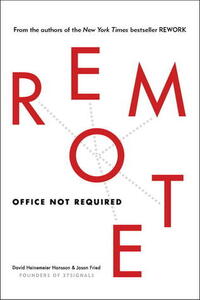Take a photo of a barcode or cover
It feels like the Bible for remote work. A bit outdated, but still relevant. Although I might say the latter about the Bible...
Anyways. Well written. Complete. And light enough to read through quickly. Might be interesting for them to bring the book up to date (mainly if tooling is concerned).
Anyways. Well written. Complete. And light enough to read through quickly. Might be interesting for them to bring the book up to date (mainly if tooling is concerned).
This wasn't as in-dept or well-researched as I had hoped, and it skews very heavily toward to programming and web development side of things. I was disappointed because I had expected a less inductive and less industry-specific approach. I also found the writing a bit on the trite side and sometimes condescending. If the book were presented more as a memoir and guide to 37signals, I would have found it less grating (and also not read it). But as someone (an editor) who's been a remote worker for years and who plans to remain one, I found this book neither terribly enlightening nor informative. It only focused on one industry, and it didn't touch on remote work's ethical or anthropological significance—even in broad strokes—which was a missed opportunity. It reads more as a series of blog posts or magazine articles than a cohesive trade book. The last grievance I had with this book was that it comes off a bit too much like an ad for 37signals, whose products I had used for years and found lacking. If you're looking for a strongly researched account of remote work across industries that doesn't assume you've barely used the Internet, this isn't it.
A good primer on working remotely. Nothing mind-blowing in here, but it is a good collection of advice and tips.
The book has great tips for adopting remote work, but unfortunately it became a bit dated since most of us were forced to go remote. Nevertheless, this is a must-read for managers and workers who wants to get the best out of it and improve performance and work-life balance. Also it is a small book and you should finish it really quick.
This book really needs a second edition, because of the great strides that remote work has made the last 7 years.
Hell, 2020 has been a remote work miracle. I’ve been working remotely with a 20 person team and, once we got over a month or two bump, we’ve gotten MORE productive. Quality has increased and output has remained the same. Deadlines are beaten by days and weeks.
Although it’s a little dated, there are still some things to learn about.
Hell, 2020 has been a remote work miracle. I’ve been working remotely with a 20 person team and, once we got over a month or two bump, we’ve gotten MORE productive. Quality has increased and output has remained the same. Deadlines are beaten by days and weeks.
Although it’s a little dated, there are still some things to learn about.
The book is interesting but doesn't offer much advices or something precise. Anyway, I intend to become a digital nomad so this book gave more willingness to do this step.
I've read it again. It's an awesome book for those who are starting remote. It can point the solution and problems in a straight way. But it doesn't go deep on solve problems criticized, also the solutions presented in the book are not the only ones and would not be well received/viable in all remote companies.
And, if you're focused it will take a 2, at most 3 hours to read, so it totally whort the time.
And, if you're focused it will take a 2, at most 3 hours to read, so it totally whort the time.
Every employee knows that interruptions and meetings interfere with productivity; that the best work typically gets done solo, working in sprints and that managers need to learn to trust the people they've hired to do the job.
The approach to "Remote" work by Jason Fried and David Heinemeier Hansson of 37 Signals can be summed up succinctly as "Try it, you'll like it."
If you're manager or business owner trying to understand whether remote arrangements might be effective at your company, this book just might put you over the edge. The 37 Signals founders use examples from their own experiences and others to enumerate the benefits of and alleviate the fears surrounding remote work. They explain how to keep employees feeling connected in self-paced remote teams that still manage to get things done and spend a lot of time on the right way to trial remote working arrangements within an organization with little risk.
If you're already convinced that remote work is a normal way of doing business (like myself), then there's little here that will be new or useful to you. After all, even a corner office with floor-to-ceiling windows, a free lunch and a twisty slide with a ball pit can't compare to the office of Anywhere-you-want-to-be.
However, if you're trying to legitimize a remote working arrangement with your current employer, the recommendations found in "Remote" could help you build a glide path to escaping the office for good.
The approach to "Remote" work by Jason Fried and David Heinemeier Hansson of 37 Signals can be summed up succinctly as "Try it, you'll like it."
If you're manager or business owner trying to understand whether remote arrangements might be effective at your company, this book just might put you over the edge. The 37 Signals founders use examples from their own experiences and others to enumerate the benefits of and alleviate the fears surrounding remote work. They explain how to keep employees feeling connected in self-paced remote teams that still manage to get things done and spend a lot of time on the right way to trial remote working arrangements within an organization with little risk.
If you're already convinced that remote work is a normal way of doing business (like myself), then there's little here that will be new or useful to you. After all, even a corner office with floor-to-ceiling windows, a free lunch and a twisty slide with a ball pit can't compare to the office of Anywhere-you-want-to-be.
However, if you're trying to legitimize a remote working arrangement with your current employer, the recommendations found in "Remote" could help you build a glide path to escaping the office for good.
informative
fast-paced
Having worked remotely for over 9 years, I was really hoping to get something more from this book. Tips? Insights? Suggestions? Any kind of research? Instead it felt like an advertisement for their products and like it could have been an article rather than a book.
Also... They mention in the book that 40% of IBM's 380,000 employees telecommute full time but then they go on and on about how it's innovative and new. Just really felt like they were focusing on the experience of their small 36 person company rather than entire industry trends.
Also... They mention in the book that 40% of IBM's 380,000 employees telecommute full time but then they go on and on about how it's innovative and new. Just really felt like they were focusing on the experience of their small 36 person company rather than entire industry trends.




